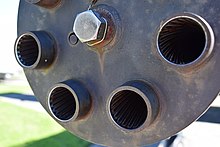
Back حلزنة Arabic Наразная зброя Byelorussian Нарезни оръжия Bulgarian Ànima estriada Catalan Vývrt hlavně Czech Картлă хĕçпăшал CV Rhigoliad Welsh Zug (Waffe) German Ánima rayada Spanish خان (اسلحه) Persian



Rifling is the term for helical grooves machined into the internal surface of a firearms's barrel for imparting a spin to a projectile to improve its aerodynamic stability and accuracy. It is also the term (as a verb) for creating such grooves.
Rifling is measured in twist rate, the distance the rifling takes to complete one full revolution, expressed as a ratio with 1 as its base (e.g., 1:10 inches (25 cm)). A shorter distance/lower ratio indicates a faster twist, generating a higher spin rate (and greater projectile stability and accuracy).
The combination of length, weight, and shape of a projectile determines the twist rate needed to gyroscopically stabilize it: barrels intended for short, large-diameter projectiles such as spherical lead balls require a very low twist rate, such as 1 turn in 48 inches (122 cm).[1] Barrels intended for long, small-diameter projectiles, such as the ultra-low-drag 80-grain 0.223 inch bullets (5.2 g, 5.56 mm), use twist rates of 1 turn in 8 inches (20 cm) or faster.[2]
Rifling which increases the twist rate from breech to muzzle is called a gain or progressive twist; a rate which decreases down the length of a barrel is undesirable because it cannot reliably stabilize the projectile as it travels down the bore.[3][4]
An extremely long projectile, such as a flechette, requires impractically high twist rates to stabilize; it is often stabilized aerodynamically instead. An aerodynamically stabilized projectile can be fired from a smoothbore barrel without a reduction in accuracy.
- ^ Smith, Randy D. "The .54 Caliber Muzzleloader". Chuck Hawks. Archived from the original on 2008-08-11. Retrieved 2008-08-19.
- ^ "Products::Rifle Barrels::Calibers and Twists". Shilen Rifles, Inc. Archived from the original on 2007-09-27. Retrieved 2008-08-19.
- ^ "gain twist". MidwayUSA GunTec Dictionary. Archived from the original on 2009-02-15. Retrieved 2008-08-19.
- ^ Lilja, Dan. "What makes a barrel accurate?". Archived from the original on 2007-08-30.
© MMXXIII Rich X Search. We shall prevail. All rights reserved. Rich X Search